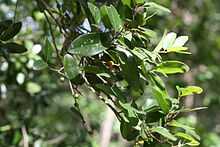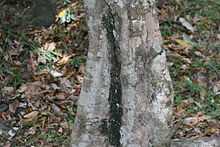Drypetes sepiaria
| Drypetes sepiaria | |
|---|---|
.jpg) | |
| Drypetes sepiaria fruits & leaves | |
| Scientific classification | |
| Kingdom: | Plantae |
| (unranked): | Angiosperms |
| (unranked): | Eudicots |
| (unranked): | Rosids |
| Order: | Malpighiales |
| Family: | Putranjivaceae |
| Genus: | Drypetes |
| Species: | D. sepiaria |
| Binomial name | |
| Drypetes sepiaria (Wight & Arn.) Pax & K.Hoffm. | |
Drypetes sepiaria is a plant species of the genus Drypetes and the family Putranjivaceae.[1] This tree is very common in India and Sri Lanka. It is known by many other names in various languges, including Vellakasavu, Veeramaram in Malayalam, Vellilambu, Veerai (வீரை), Aadumilukkan, Kaayalakkamaram in Tamil and Weera (වීර) in Sinhala.[2]
Description


The inflorescence flowers are bracteolate, axillary clusters or short racemes. The fruits are crimson in color, small sphere in shape and fusiform drupe. The mature leaves are broadly oval-oblong and base cordate to rounded in shape and glossy on the upper side. The young leaves are light green in color, turning dark green as they mature. The trunk are often gnarled, twisted or flutes, rigid, much-branched and puberulous.
It grows in monsoon forest and scrub lands.
Uses
The tree has edible tropical fruit. Its trunk uses in fence and other mature branch and fence use as firewood.
Research
The aim of this study was to investigate in vitro antioxidant, anti-inflammatory and cytotoxic activities of the petroleum ether, ethyl acetate, methanol and aqueous extracts obtained from leaves of Drypetes sepiaria. Total phenolic and flavonoid contents of these crude extracts were determined as gallic acid and quercetin equivalents, respectively. In in vitro antioxidant method, methanol extract exhibited higher free radical scavenging activity compared to standard compound, ascorbic acid with IC50 of 95.43 µg/ml (DPPH) and 67.05 µg/ml (ABTS). Methanol extract was able to inhibit inflammation by in vitro about 85-90% (HRBC stabilization method) and in vivo about 40-45% (Paw oedema method) anti-inflammatory assays compared to standard produced 50.04% at 6h period. In cytotoxicity assay (MTT assay) methanolic extract exhibited IC50 of 10 µg/ml. In apoptosis (flow cytometric assay), the control group showed normal caspase 3 activity in the SiHa cells which was 0.24%, and increased up to 40% after treatment.
References
- ↑ "Drypetes sepiaria (Wight & Arn.) Pax & K.Hoffm". Retrieved 19 April 2015.
- ↑ "Drypetes sepiaria (Wight & Arn.) Pax & K.Hoffm". Indian Biodiversity. Retrieved 19 April 2015.
- Gadamsetty, G; Maru, S; Tyagi, A; Chakravarthula, S. N. (2013). "Anti-inflammatory, cytotoxic and antioxidant effects of methanolic extracts of Drypetes sepiaria (Euphorbiaceae)". African journal of traditional, complementary, and alternative medicines : AJTCAM / African Networks on Ethnomedicines 10 (5): 274–82. PMC 3847416. PMID 24311836.
External links
| Wikimedia Commons has media related to Drypetes sepiaria. |